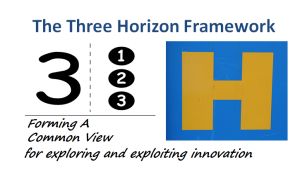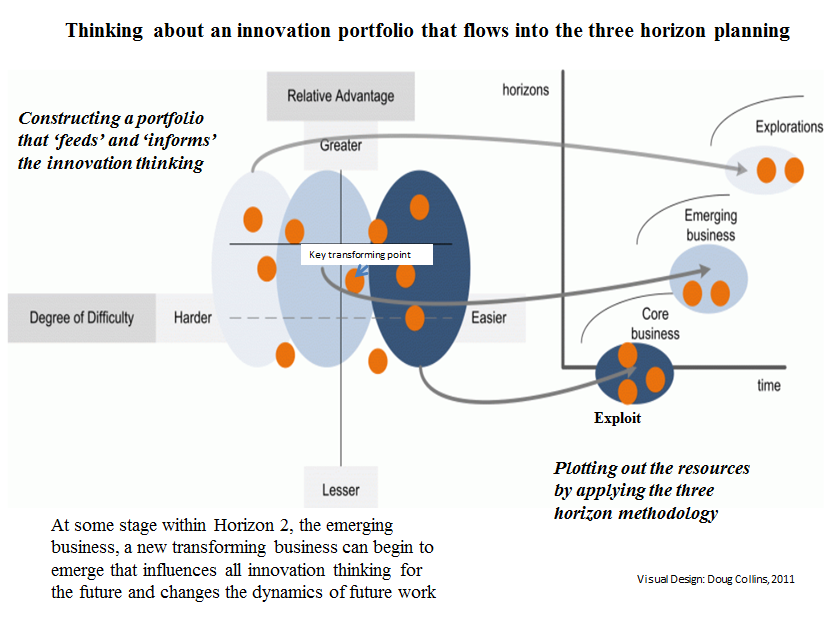 In the past few days, I have had some exchanges on twitter with Jairo H Venegas and Ralph-Christian Ohr on different thinking around the three horizon methodology. We share similar views on its value and partly how it can be applied.
In the past few days, I have had some exchanges on twitter with Jairo H Venegas and Ralph-Christian Ohr on different thinking around the three horizon methodology. We share similar views on its value and partly how it can be applied.
Ralph and I exchange constantly and occasionally meet up together. Actually, we need another meeting Ralph to catch up and explore these mutual innovation value points.
Ralph in a reply to Jairo suggested this: “That’s why a portfolio approach is so important” – with his take here: bit.ly/1Rn5Svq under his excellent Model for Integrative Innovation article.He ‘talks’ of cornerstones and offers different premises to anchor these a little more.
The different premise: premise 1: Innovation management follows a balanced portfolio approach. The entire innovation portfolio is divided into exploitation-oriented and exploration-oriented innovation initiatives and premise 2: Senior management is committed to attributing equal importance to exploitation and exploration initiatives as both are vital for a company to thrive sustainably. Then premise 3: Exploitation- and exploration-oriented initiatives are separated in terms of organisational anchoring, governance and funding and finally premise 4: Fostering an innovation portfolio is enabled by a proper idea management system which allows to either assign an internal or external idea to the corresponding units or to reject it. Then he suggests the use of the three horizons as distinct playgrounds for innovation initiatives.
This brief summary does not do justice to Ralph’s thoughtful build up to this portfolio approach and use the three horizons as a framing for this.I do recommend reading this. The link again is here: bit.ly/1Rn5Svq
Well Ralph’s article leads nicely into this visual I have used and I wanted to contribute further to this collective thinking around different approaches to planning out innovation and in particular in this brief exchange, we were recently having on twitter by giving it a little more context this through this visualisation.
This visual might help make a further contribution to the value and use of the three horizon methodology

I like this visual as it places the portfolio discussion into its degree of difficulty parts to build a portfolio up without assigning it to time at this stage. That comes next through the use of the three horizons where you are exploiting and exploring these opportunities over time.
Changing the annual plan thinking is critical to building a robust innovation portfolio.
The usual arguments of how do you fit these into an annual plan tend to reduce, you are focusing on the attractiveness of different opportunities and time becomes not the issue at this point, that can come back into the thinking later. As you evaluate the degree of difficulty you start assigning different resources and recognising a ‘span’ of different times to bring these idea concepts to realisation.
You will notice in the middle of this visual there is a key transforming point.
I believe if you are genuinely looking across different options and broader opportunities you can begin to see a transforming opportunity that has the potential to radically alter or drive your business in the future.
This sits in the middle as it becomes an emerging idea, that goes into the horizon two part. This needs really carefully handling and I have previously written about this horizon two specifically in an article here called Traversing across into horizon 2 for new breaking innovation.
Also, I would want you to go back and read two articles, firstly on why innovation needs a different time and thinking horizons and then drawing out the different voices within the three horizons methodology for innovation. That way I don’t need to repeat parts of them here.
Recognising our present day thinking are at odds with future thinking
So you get these clear sense that many are sceptical or pay lip service to the products or service offerings of the future as the thinking, judgement and value orientation are at such odds with the existing measures and metrics they apply to run today’s business and how they get judged.
We must move our thinking beyond the ‘here and now’ and push it into the future if we want to transform our innovation and that takes a very different mindset and where the three horizon framework can help significantly in balancing any innovation portfolio.
So to add to the short exchange on twitter I thought I’d share this visual that might help in plotting your balanced portfolio in a way that combines portfolio management and three horizon thinking for recognising time and allocating resource
The potential of using the three horizons to any blue sky thinking, or determine what makes up the portfolio, is a more classic positioning but why not, once you have determined your opportunities in the portfolio you place them back into the three horizons to manage them ‘going forward’.
Just an additional thought or two as you finish up here.
By the way in my insights and thinking tag on this site you have an extensive collection of thoughts around the three horizon methodology, including white papers and different ‘series’ collections to give you a fairly comprehensive view of this most valuable 3H methodology.
End note: Doug Collins has pointed out since this publication, that he was original source of this visual. I had lost this reference and I am happy to add it in. His original article adds well to this.
Paul, thank you for the kind words on the visual. It appears at the end of my 2011 article, “Moving from the Front to the Back End of Innovation: Idea Evaluation.”
The link can be found here…
http://www.innovationmanagement.se/2011/12/13/moving-from-the-front-to-the-back-end-of-innovation-idea-evaluation/